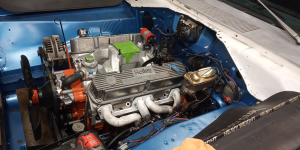RUSTY Cuda
In over my head!
I think there's a little lever you flip to release the rollers, I have a lincoln but not that #?

The two are mutually exclusive, in my experience. Sure, they may be quiet for the first couple of thousand miles, but every straight-through muffler I've heard sounds like a glasspack in pretty short order: loud, resonant, and blatty. It's a personal preference, of course, but definitely not my thing.I see a big muffler on the shelf there that came with a Duster I had. According to the guy I got it from there's something desirable about those, like the Caddy mufflers that were used on the Silver Bullet only not famousSomething like they'er 2.5" straight through and quiet or something like that.
That's my one true talent.I have to shake my head and look at the ceiling when someone over-complicates something.
That's what the factory did. If you've got fuel and the timing right, it should fire nearly instantly.I'm just going to stop with this unnecessary frustration. It was pre-lubed and will be relubed quickly enough once I start cranking the engine.
That's not information I'd use. That can be a lot of turning with no oil pressure. I'd use a priming shaft just long enough to hear the drill's pitch drop. At that point the pump is primed. I'd prefer that the engine start ASAP and the oil pump do the rest. I use break-in lube on virtually everything including the valve stems, rocker fulcrums and tips, and both ends of the pushrods. They'll survive the second or two preceding pressurization.FWIW That useless engine book I bought had one bit of info I could use - pull the coil wire and spin the engine to a count of 5 and repeat until you get oil pressure.
There's plenty of valve action to start the engine without pressurizing the lifters. Valves are open now with it just sitting; were that not the case, preload could be adjusted with no crank rotation. As I mentioned in the asterisked part of this post, you don't want the lifters pressurized on first start. Even if a valve doesn't hang, there's full valvespring pressure (x 1.5--rocker ratio) on the lifter faces before they're getting oiled (there's no splash oiling). To the second half of the statement: That's why I pre-lubricate all the valvetrain, even though the rocker fulcrums are the only pressurized parts in that subsystem.I think that's because you gotta pump up the lifters or you'll be trying to fire with no valve action until they pump up, but it will also pump oil to the top.

If the bead is thicker than the cork gasket, you're fine. 1/4" is more than sufficient.I know now why I don't like not using the cork under the intake manifold - I can't see to tell if I gobbed enough RTV in the gap at the rear of the engine. I think I did but it would be good to see it for sure.
Yeah, the hoses have all been cut to fit for decades now. It makes sense from a manufacturing standpoint, since the radiator fittings' locations are relatively close across body styles--even trucks.Tomorrow starts with the rad and shroud, then the cut-to-fit hoses. I even had to trim the bypass hose.

I'm pretty sure every vintage upper/lower hose available at this point was originally a truck version, which explains the excessive length and need to cut.You have to cut both ends of the lower hose and I managed to cut the rad end of it when I should've cut the water pump end. Somehow I got it turned around between the prior cut and checking fit. At least AZ has it in stock.
I've never even seen them before today; I had to do a search. I guess they'd be great for a roadside repair, in race pits, or engines going on/coming off the dyno stand. If Motor Trend/Hot Rod has started pushing them, I'm sure I'll start seeing tons of 'em in online photos and at the few car shows I bother to attend. People might even start asking for 'em at our store. Magazine sheep are easily led.I've been seeing thumbscrew hose clamps on Motor Trend. I'm sure they're getting them for free. Have any experience with those? Seems like a one or two time convenience so I'm skeptical if they cost more. (I've already got clamps)
Those Powergrip clamps are awesome, but can get expensive fast since the only way to remove 'em is to destroy them. I've got some of those on the Valiant back by the fuel tank.On my Roadster I went with the OE Corbin clamps at the radiator, but Gates Powergrip on the engine side, and the lower hose that goes to a pipe on the body.
Bastards!AZ lied.
I think it might be, based on the fact that the OE ThermoQuad intakes are pretty danged high rise (in '71, there was a 3/16" spacer beneath the carb to boot, with a gasket on either side of it). If you want carb-pad measurements on a stock intake, I've got a few lying around including a '71 340. I can set a Holley on it if you need an air-horn measurement.I've got to do something about an accelerator cable. I don't know if a stock one is long enough with the air gap manifold or not.
Don't feel too bad. Lokar parts have a well-earned reputation for being garbage.This is what I broke.
Lokar WCA-1034 Lokar Cable Fittings | Summit Racing
